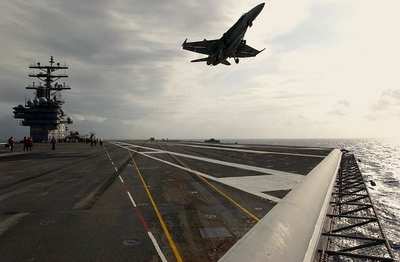Much like successful
investors, "Gold Eagle" plane captains attached to Carrier Air Wing
(CVW) 9 and embarked aboard USS Carl Vinson (CVN 70)
receive generous dividends for the work they do and the amount of
time they devote to their assigned assets.
Otherwise referred to as "brown shirts," plane captains invest
long days, hard work and every ounce of their knowledge and
experience into ensuring multimillion dollar aircraft and their
pilots make it safely back to the deck every day.
According to the Naval Safety Center, modern naval aircraft are
inherently complex, and plane captains often represent the sole
source of expertise on daily and turnaround inspections.
"Trust is the key. The pilots have to trust that
everything’s been inspected properly," said Aviation
Structural Mechanic 3rd Class Keston Raymond, Helicopter
Anti-Submarine Squadron (HS) 8 plane captain.
"It’s a good feeling when you know you’ve gained
their trust."
Plane captains spend 12 to 15 hours per day with their assigned
aircraft. In addition to the constant inspections, brown shirts
check fluid levels, prepare the cockpit for flight and ensure there
is no foreign object debris that could damage the bird. Prior to
handing the aircraft over to the pilot, the plane captains act as
the final set of eyes.
"They prep the jets and get us ready to go," said Lt. Eric
Taylor, one of Fighter/Attack Squadron (VFA) 147’s F/A-18
Hornet pilots. "Without them, we couldn’t do our jobs. We
couldn’t go flying."
"The responsibility can sometimes be overwhelming," said
Terrero. "Plane captains are like a safety for the (aircraft). I
have the best idea of what’s happening with my F/A-18."
Although Navy plane captains tend to be some of the most junior
personnel in the squadrons, the responsibility can be enormous. The
plane, pilot and mission can rest squarely on their shoulders. "No
matter what rank the plane captain is, he controls the jet," said
Aviation Machinist’s Mate Airman Xavier Terrero, one of
VFA-146’s plane captains.
After coming to life in the squadron’s line division, they
spend anywhere from six months to a year fulfilling plane captain
duties before moving on to a more permanent job within the
squadron.
"Being assigned temporarily to the squadron’s line
division gives the junior guys an idea of how the squadron operates
… how it supports the Navy’s mission," said
Taylor.

Sailors spend a minimum of 90 days learning the ins-and-outs
before they can receive the prestigious title of plane captain, and
have their names and hometowns stenciled on the belly of an
aircraft. "(The initial training) gives them experience and
knowledge of the airplane above and beyond (others) that go
straight to work in their rate," said Aviation Ordnanceman 1st
Class (AW) Dru Bond.
Terrero has been a plane captain for almost six months and will
soon move on to his job as an aviation machinist’s mate. At
just 19, Terrero’s work as a plane captain has not only given
him an advantage over his peers, but plenty of tales to tell.
"Growing up, I listened to my grandfather’s stories; now I
get to tell him mine," said Terrero. "Working as a plane captain
has been a great learning experience. I’ll always be a plane
captain."
[Thanks to Journalist 1st Class (SW) Tony Sisti, USS Carl Vinson
Public Affairs --ed.]
 ANN's Daily Aero-Term (04.14.24): Maximum Authorized Altitude
ANN's Daily Aero-Term (04.14.24): Maximum Authorized Altitude ANN's Daily Aero-Linx (04.14.24)
ANN's Daily Aero-Linx (04.14.24) Classic Aero-TV: 'We're Surviving'-- Kyle Franklin Describes Airshow Life 2013
Classic Aero-TV: 'We're Surviving'-- Kyle Franklin Describes Airshow Life 2013 Aero-News: Quote of the Day (04.14.24)
Aero-News: Quote of the Day (04.14.24) Airborne 04.09.24: SnF24!, Piper-DeltaHawk!, Fisher Update, Junkers
Airborne 04.09.24: SnF24!, Piper-DeltaHawk!, Fisher Update, Junkers



